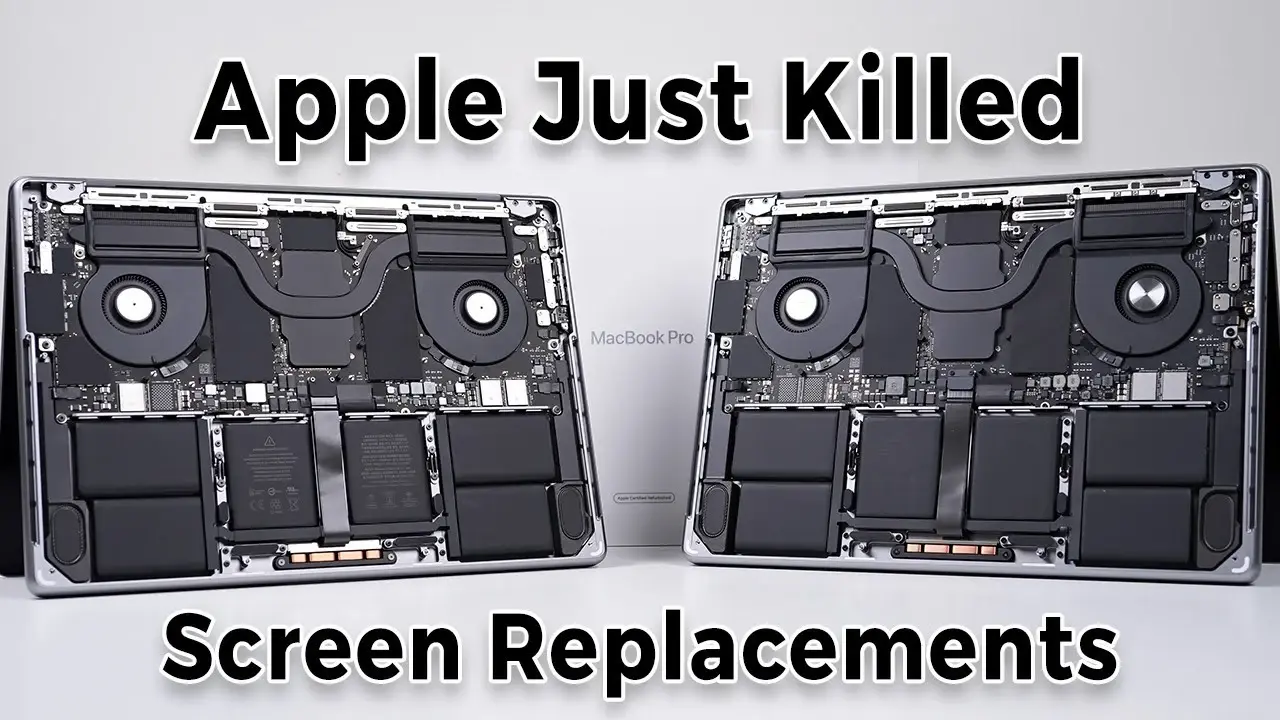- cross-posted to:
- right2repair@discuss.tchncs.de
No surprises here. Just like the lockdown on iPhone screen and part replacements, Macbooks suffer from the same Apple’s anti-repair and anti-consumer bullshit. Battery glued, ssd soldered in and can’t even swap parts with other official parts. 6000$ laptop and you don’t even own it.

Framework laptops are getting better. Not Apple levels good, but it certainly beats them in average longevity.
The only hope with Apple is having the EU step in again to stop this kind of bullcrap.

I love the idea of Framework and I want to get one, but the price is multiple times of what I paid for my current machine… and this is better than the Framework in several ways. I’m hoping that a few of the Frameworks make it onto the second hand market and I’ll buy one there. The idea of a laptop that’s easy to replace and lasts forever is brilliant though, and I hope they take off.

What did you get and for how much? To me it seems the framework (at least the 16) is only a bit (100-200 out of 1600) more expensive than laptops with similar specs.

I paid approx $700 for a i5 with a Geforce 3050 and a 144hz screen. The RAM was weak but it was upgrade able so I got it up to 40GB, about $800 all up. It’s an MSI.
The only downside is that it’s such a pain to take apart and it’s put together in a way where there’s a very real chance of doing permanent damage when taking off the cover, since the case actually wraps around the ports and makes the motherboard bend when you apply any pressure to it. It came with 8GB of RAM out of the box, so basically unusable without the upgrade; still, I’m very happy with it atm.

I would love a Framework laptop, but my current laptop (a Dell XPS 15 from 2017) is still going strong. Buying a new repairable laptop defeats the whole sustainable thing if there’s nothing wrong with my current one. I’ve done 2 fixes to my current laptop: Replaced the speakers that had died, and added thermal pads to the VRMs to fix an overheating / throttling issue. Even the battery is fine still.

Agreed, a lot of people get into sustainability and rush out to buy sustainable stuff. Even with something like a plastic bag, it’s better to use it for as long as you reasonably can than to throw it away and rush out to buy an organic cotton one.

Hey there, fellow 2017er! Different worlds, I know, but I’m just finding out my specific model 2017 MacBook Pro–the 13" without a “touchbar”–was the last model with a replaceable SSD, so I’m about to upgrade it to 2TB. Eventually I’ll probably replace its battery, but, for now, I’m even pretty happy with the remaining battery capacity. I’m just hoping it keeps working long enough for the right-to-repair movement to force Apple back to replaceable wear-and-tear parts (particularly SSD and battery) before I have to decide whether to choose between a completely unserviceable replacement model or switching platforms again.

another example of why apple laptops are so expensive.
80% of the price is to cover the R&D for fucking over the consumer.
Seriously, tying the goddamn *hall effect sensor to the system so it cant be replaced? Thats some freaking cyberpunk level corpo shitbaggery.

You’ll own nothing and be happy.

All of their products are anti consumer and they have been for years. I don’t understand why people still buy their products

They’re great work laptops, as long as you treat them as basically disposable. If I have a problem, just turn it into IT and grab another, pull down the repos and I’m off. Wouldn’t buy one with my own money, though.

They are just used to them. OS X has one specific way of working that, once you learn it, is quite good. It sucks completely if you try to use it in different way so if you don’t like magic mouse (which sucks) and don’t like using their laptop keyboard (which sucks) and touchpad you will not enjoy it. But if Mac is all you know, you’re used to their hardware and know how it works you will love it because any other OS will be different and feel way less ergonomic. In my opinion if you’re skilled Linux/Windows user will customized workflow OS X will feel limited and be painful to use. If it’s you first computer or you don’t have any established workflow you will like it a lot.

It sucks completely if you try to use it in different way so if you don’t like magic mouse (which sucks) and don’t like using their laptop keyboard (which sucks) and touchpad you will not enjoy it.
This isn’t true for me. I use the same (cheap Logitech) mouse with Win11, Linux, and my MBPs. What’s meant to be the issue? It’s just like every other setup I’ve used in the last 30 years.

In my experience the only quick way to switch between windows of the same app, different apps, maximized apps and virtual desktops is using magic mouse/touchpad gestures. Without them it’s simply painful. Maybe you found some setup that works for you but I wasn’t able to reproduce the way I like to use WM in OS X. For example I use keyboard shortcuts to move windows between monitors and according to this https://apple.stackexchange.com/questions/367858/does-macos-have-a-keyboard-shortcut-for-moving-an-individual-window-to-another-m in OS X it was only made possible in 2020 (I stopped using OS X before that) or you had to use 3rd party app. Same with sending windows to different desktops: https://superuser.com/questions/184763/is-there-a-way-to-move-the-current-window-to-another-desktop-without-using-a-mou

That’s a really interesting answer - it all makes sense that those things can be irritating, and also why I had no idea about them:
For years I have had my applications and windows (IDE, tabbed console, browser(s)) set up in fixed positions. I rarely switch between them in a way which isn’t a keyboard shortcut (99% command-tab) or involves the mouse anyway (for testing, or video calls). I never normally move windows between screens or anything like that in my workflow.
In the good and very old days I literally just had emacs maximised and that was it, all day long 😇
I guess I got lucky in a sense - that not needing functionality meant I wasn’t affected by it being missing, but it might partly be a positive side effect of desiring simplicity and less from the WM so I can focus on my own things.

Yes, that’s exactly my view of OS X. If you can adapt your workflow to its limited functionality you will have a pretty stable, simple, easy to use environment. If you’re workflow doesn’t fit you’re out of luck and using it will be very painful. Linux on the other hand just offers you all the settings you need so everyone can work the way they like.

I can’t stand their keyboards. The keys have virtually no travel on them, they’re all low profile, and for some insane reason that I can’t work out, because isn’t their core market supposed to be audio engineers and graphic artists, the keyboards have no buttons for bindable macros.
Meanwhile I can get an excellent keyboard with decent travel and macro buttons for very little money. I get why the keyboards have to be low profile on laptops but why do they also have low profile keyboards for desktops? They are objectively the worst possible keyboard for a desktop. But they look sleek and modern so I guess that’s all that’s important. And because they are anti everything they are anti-choice, so I don’t get an alternate option, and have to buy an independent keyboard.

I don’t any more because of this kind of thing but I can understand. A few points at the top of my head
-
Great desktop OS (note how Windows and Linux still to this day have inconsistencies on high DPI displays, to name just one example!
-
Integration between them is good
-
Security and privacy practices are great
-
The phones are very consistent with camera quality and battery life
-

So, genuine question.
What other laptops are there with comparable screens? Colour gamut, accuracy and all the good stuff Apple does so well.
Some day I might need something to work with on the go, and I need a good display.
Edit: Well, didn’t expect so many answers in as little time, thank you

Basically, none.
A display is only as good, as the OS running it. Otherwise you’re seeing random, usually oversaturated shizzle.macOS is still the only, properly color-managed OS. (Usually running P3 displays)
If you have a windows laptop with a display that’s not sRGB, you’re in for some “fun”, if you’re doing any sort of creative or design work.
Edit: I’m getting downvoted because “apple bad >:(”?

Is this what you are talking about?
https://devblogs.microsoft.com/directx/auto-color-management/OS level colour calibration and management, regardless of the app?
New feature in Windows 11 2022.
Is this what you are talking about?
Yes.
BUT.Can you turn it on?
New feature in Windows 11 2022.
As available as “full-self-driving-next-year”. Planned for 23H2.
You have to be a “Windows insider” run beta-test version of windows, and set it up via .bat from github.
That being said, I am a “windows insider” and I do run their beta-test OS, and I still don’t have that feature.
I’ll believe it’s released and tested, because the quality of my work directly depends on it.
It’s also going to be available for 12th+ gen iGPUs only, which means that any laptop running a wider-gamut built-in-monitor with an older iGPU can get fucked.
I appreciate the ‘gotcha’ tone.

Hmm, fair.
There is also the colour profile system.
https://support.microsoft.com/en-us/windows/about-color-management-2a2ed8fa-cf09-83c5-e55c-d1428519f616I just tested it on my computer. Installed the “driver” for my monitor, which then loaded the correct profile for it (changing from the “generic PnP” driver/profile to one for my specific model).
It certainly changed the look of my monitor.
I’ll have to test drive it a bit.But I guess it’s deeper than that, isn’t it.
Like, if that sets the colour profile to sRGB, and I’m dealing with BT.2020… although that would be bonkers cause I don’t think sRGB can represent BT.2020.Color standards break my brain.

Your monitor has a very specific set of RGB lights that need a profile made for that specific monitor. Loading random profiles from the internet will result in incorrect colors in some areas. The one that comes with the driver is closest you can get without a calibrator.
The wcm in your link is the standard Windows Color Management which only works with a handful of windows Apps. Rest is a random mixture of unmanaged, locally managed, and Windows managed colors.
My advice is, it seems that you have an external display, set that to “sRGB” via the buttons on the monitor, and set the driver-installed profile to sRGB. If you have such options. This is the only way to get as close to “correct color” on Windows without much effort and worry about color management.

I’ve been using a Lenovo Yoga Pro 9i (or Slim Pro 9i if you’re in the US) for around half a year now and have been loving it so far. 14" MiniLED screen, 100% DCI-P3, can get really bright, has a touch screen (if that’s something you like) and a 165 Hz refresh rate. Can’t speak for the color accuracy though.
I got the i9 variant with 32GB RAM and an RTX 4060 GPU during a “Mega Power” sale and with an additional 10% off as a Student for just over 2000€, but even the normal price is “only” (compared to your MacBooks and XPSs) around 2500€ iirc.
RAM is sadly soldered onto the motherboard but at least you get 6400MHz for it. Storage is upgradeable.
Connectivity is great (2x USB-C with PD3.1 for 140W charging, one also supporting Thunderbolt 4, HDMI, full-size SD Card reader, 2x USB-A…)

Dell precision 5570.
I own a MacBook Air now but prior to that I’ve used thinkpad, dell xps, Asus zenbook and hp envy lineups.
If i were to ditch MacBook I’d have picked up a zenbook since they’re budget friendly, great oled screen, long battery life, lightweight and good build quality. You can even do casual gaming on it.
The biggest thing i miss switching to mac has been losing my steam library and unable to play games with my friends.

I own recent OLED Zenbook and it’s super creaky squeaky, plus, the screen unglued itself from the frame. The build quality isn’t very good I’d say.

Maybe the ProArt Studiobook from Asus

None that I’ve met. But that’s why they’re apple. They get to control everything on their hardware.
But I’m happy running a framework 13 for a few business trips and I love it.
Battery is not too amazing. Hitting only about 5-6 hours rather than the 8-10 that I truly want.

I’ve used Macs for a while, but I’d take Frameworks over Macs now. The fun at the start of having a mac is not worth all the hassles that come down the line when things start failing and can’t be fixed.

They bring a sex doll to their meetings and spend hours trying to figure out the best way to fuck consumers.

It’s so annoying. I want to love Apple, heck I’ve been there and HAD Apple everything. They have a great *nix OS, well polished ecosystem, very good security and privacy practices… but hostility towards repair, along with planned obsolescence, ended up turning me off. One aspect is sustainability. Repair is more sustainable than recycle. They have good recycling credentials but that should be last resort.

It’s tight to balance between the demand on how impossibly small things are getting, the space requirements for user serviceable latches, and just straight up reduction in component sizes.
I remember back when it was easy to desolder a capacitor/vacuum tube to replace a part; then they got smaller and replaced by IC chips. I remember back when we can just pull out a and replace memory modules on cards; then they got soldered on, but hey the card can still be ripped out of the PCI slots and replaced. Now we’re seeing the GPU, CPU, and memory all getting smaller, all getting fused into a single SOC on the ever shrinking logic board… It is just the inevitable future if the world continues to want things smaller (to fit in pockets) and faster (lesser distance for signal to travel).
Unpopular opinion: I find this whole “right to repair” really pointless endeavour pushed by repair shops wanting to retain their outdated business model. In 50 years, when the entire system that’s more powerful than the most powerful supercomputer today lives entirely in the stem of your glasses, and the display is fused into the lens or projection, no one will have the necessary tools to pull apart the systems nor the physical precision to repair things… and that future will come, whether these right to repair people want it or not.
It is probably better use of our collective resources to focus on researching technologies that will help us deconstruct these tiny components into their constituent matters (stable chemical compounds), such that they can be reused to build into newer equipments, as opposed to sitting in a landfill never being used again.

I take issue with some of the statements here. First of all:
I find this whole “right to repair” really pointless endeavour pushed by repair shops wanting to retain their outdated business model.
Right to repair is definitely not just being pushed by repair shops. If you take a good look at the rate Framework is selling devices at (batches instantly sold out until Q1 2024), you’ll see that consumers want this more than any other group. We, as the consumers will ultimately benefit the most from having repair options available. Right to repair is not meant to halt innovation, it is not about forcing manufacturers to design products in ways detrimental to the functioning of said products. It is about making sure they don’t lock third parties out of the supply chain. If you replace a traditional capacitor with a SMD variant, someone is going to learn to micro solder. If you convert a chip from socketed to BGA mount, someone is going to learn how to use a heat plate and hot air gun to solder it back in to place.
The main problem is manufacturers demonstrably going out of their way to prevent the feasable.
The second part I take issue with is this:
It is probably better use of our collective resources to focus on researching technologies that will help us deconstruct these tiny components into their constituent matters
From my 12 years of experience in design of consumer goods and engineering for manufacturing I can tell you this is not happening because no one is going to pay for it. The more tightly you bond these “constituent matters” together, the more time, energy, reasearch and money it will require to convert them back into useful resources.
There is only one proper way to solve this problem and it is to include reclamation of resources into the product lifecycle design. Which is currently not widely done because companies put profits before sustainability. And this model will be upheld until legislation puts a halt to it or until earth’s resources run out.
In terms of sustainability the desireable order of action is as follows:
- reduce: make it so you need less resources overall
- prolong: make it so you can make do as long as possible with your resources. this part includes repair when needed
- reuse: make it so that a product can be used for the same purpose again. this part includes repair when needed
- repurpose: make it so that a product can be used for a secondary purpose
- recycle: turn a product into resources to be used for making new products
- burn: turn the product into usable energy (by burning trash in power stations for example)
- dispose: usually landfill

Only thing is that repair technically should belong to “prolong” I think, so even more desireable.

I can see an eventual future when the cores, RAM and storage are all on one IC or something which would also be great for performance (I just bought a desktop processor that does some clever stacking of extra L3 cache on top of the cores). As others said though we’re not quite there yet.
Ever since Steve Jobs (I think perhaps as a way of coping with illness making him thinner himself) Apple has done this thing of telling consumers that they want thinner, thinner, thinner at all costs (and other manufacturers following Apple because of course they do) but I’ve seen no real evidence of consumers actually wanting this. I for one (and I know I’m far from the only one) don’t actually mind a bit more thickness if it means a bigger battery, using an M.2 slot (oh no a few mm difference) etc.

Yeah I’d love them to rid the camera mesa plateau by flushing the back with extra thick battery… but apparently consumers don’t want the extra weight… 🤷 can’t win them all I guess.

This sounds like it’s better to wait for imaginary benefits than do the things we really can do. Anyway, there is absolutely no reason not to repair things even if you want your scifi disassembler. Our collective resources are not strained in the slightest by repairs.
In the very long term you are right. The thing is we aren’t there yet. Lots of companies are making things unrepairable for no reason right now. This is at a time when we need to produce less stuff to help the environment.

I agree we’re long way from it; but, I don’t think the secure signing of components would necessarily equates to “no reason”, though, that’s definitely not a blanket statement. Personally I’m huge proponent for locking down components with secure signing on the portable devices — less likely to experience theft, if thieves cannot get into the device nor salvage for parts (though right now they just skim passcode and reset iCloud account to circumvent it; but this can be fixed with more security around the workflow). However, for fixed devices, it makes less sense.
Yeah nah. Signing components isn’t gonna stop people stealing phones just like iCloud dosen’t now. Nobody apart from you actually wants this feature.

I might agree with you if the boards themselves were disposable. If a high end macbook were $300 then sure, just get a new one. But they’re $2000 or more just for an “ok” model. At that price they should be repairable.
I think people’s anger stems from the fact that it wouldn’t be hard for laptops to be repairable and in fact Apple’s putting in additional roadblocks over time to make repairing harder. At the very least, having broken components be removable would do a lot for hardware lifespan.

I mean, you were never blocked from replacing ICs. Most people just didn’t have the capability to solder. Today, IC replacement is blocked by hardware DRM.

It’s nothing new. Have you ever opened up a laser disc player or discman from 1989? Extremely intracate parts Ave mechanisms that are nearly impossible to work with.
Even a basic VCR or DVD drive has a ton of small moving parts which are difficult or impossible to fix and designed to break early and often.

Yep. And the steady march towards even smaller parts that are not user serviceable will continue to persist. The pipe dream of being able to self service will fizzle out — if not in 50 years, in an inevitable eventuality of the Computronium; good luck self repairing by rearranging literal atoms at home.

Do you need to rearrange atoms to change the display panel of your laptop?

We’re not at the computronium age yet, but as technology progress, that’s the eventuality. As such, repair shops’ attempt to rally clueless regulators to put in right to repair law is merely getting in the way and slowing down the inevitability.

It’s not just repair shops that want right to repair.

We’ll reach a point where performance improvements are largely unnecessary. Sure, governments and corps will still privately compete to get those precious nano seconds ahead on trades or whatever.

Technology doesn’t proliferate as quickly as you’d expect. Most people aren’t on the cusp of the latest and greatest. I worked for a fucking multibilliondollar international company 2 years ago, and they still pick product, and communicate inventory adjustments with pen and paper.
People rely on the previous shit they’ve bought.

I just recently had a 2020 gen MacBook pro die on me. When I took it to the genius bar, they said that it was a power issue that they couldn’t repair unless they changed the whole logic board which would cost me $500 and without the ability to recover the data on the soldered SSD. What’s worse is that they sent me to a 3rd party data recovery company to recover my data for $1200. I ended up declining the data recovery and just accepted that my data is gone and bought a thinkpad to replace the laptop.

Man fuck Apple, how can anyone purchase anything from a company like this.

The sad fact is that they get away with it because they have the best laptops out there in terms of build quality and user comfort (try using a Macbook touchpad and then any other one after it).
They also have the best software integration because they have to support a limited number of hardware configurations

… try using a Macbook touchpad and then any other one after it.
^ This.
Have been given a current Surface Pro laptop for work and must use an external mouse, or rage in frustration that my 13 yo MBP has a better functioning trackpad.
- argv_minus_one ( @argv_minus_one@beehaw.org ) 2•1 year ago
try using a Macbook touchpad and then any other one after it
I have a Dell laptop from 8ish years ago whose touchpad behaves pretty much identically to an Apple touchpad.
Software support for touchpad gestures on Linux is pretty lacking, but that’s not the hardware’s fault.

Interesting, because my last Dell was a Latitude from 2018 and the touchpad on that was utter crap compared to any Macbook with the newer Force Touch (as opposed to the older pre-2015 (or pre-2018 on Air)) touchpads.
- argv_minus_one ( @argv_minus_one@beehaw.org ) 1•1 year ago
I hadn’t heard of Force Touch, so I looked it up on Wikipedia. Isn’t that difficult to control? It sounds annoying more than anything else.

Significantly better than the old hinged ones because the feedback from clicking it is completely even across the entire thing. Can’t go back once you try, IMO.
- argv_minus_one ( @argv_minus_one@beehaw.org ) 1•1 year ago
I’ve used both hinged and non-hinged Apple touchpads, and the difference is noticeable but minor to me. Certainly not enough to make up for everything that’s wrong with Apple hardware.

I just don’t like carrying a mouse with me if I want to use my laptop as a laptop. To me the difference is pretty big.
- Kaped ( @Kaped@lemmy.ml ) 5•1 year ago
Soyboys
- EremesZorn ( @EremesZorn@beehaw.org ) 3•1 year ago
I didn’t say it, but I thought it.
- EremesZorn ( @EremesZorn@beehaw.org ) 3•1 year ago
Because they’ve somehow built a cult around their overpriced and overhyped products.
My laptop can crush anything their anti-consumer company can push out. People drool over MacBooks and they’re fucking laughable.You talking about “crushing” the Apple laptops is missing the point. Performance isn’t the main reason people buy them, it’s things like the TrackPad, software, battery life, and overall usability.

at this point i dont care about apple products.

I’d really like to buy a Mac mini but that mark up on RAM is insane, with that money I can get 8x the same amount of DDR 5
The base config it’s too limited and I can’t accept to pay 250 euro for 8 extra gigs of RAM and another 250 euro for 250 extra gigs of SSD
Now if they just sold an ITX M2 motherboard with slots for DDR 5, m.2 and PCI express, I could pay 800 euro for that…

But then it would be upgradable, and they’d lose on squeezing as much out of you as possible.

Awesome!
Always like people that fight for right to repair!
Anyone know if Louis Rossman and these and other people have done collabs or something similar?
Louis Anthony Rossmann (born November 19, 1988) [2] [3] is an American independent repair technician, YouTuber, and right to repair activist. He is the owner and operator of Rossmann Repair Group in Austin, Texas (formerly New York City ), a computer repair shop established in 2007 which specializes in logic board-level repair of MacBooks.

Considering the serious move EU as made regarding right to repair and imposing that any equipment must be repairable and have parts for it for at least 10 years, this ia going to be another serious pain for this brand.
I’ve also read an article recently where it was reported that all cell phones circulating in the EU must have replaceable batteries. And from what I took from the article it was meant replaceable by the end user.
Serious anti obsolescence legislation.
This will hurt Apple again.

Soldered in SSDs
Git gud at smd soldering dingdongs

On these machines they are proprietary SSD chips that you can’t buy anywhere.

They really did it again huh

